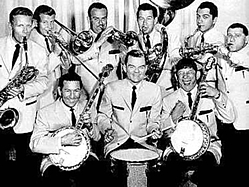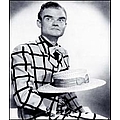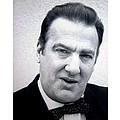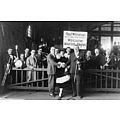Spike Jones & His City Slickers Biography
Lindley Armstrong "Spike" Jones (December 14, 1911, Long Beach, California – May 1, 1965, Beverly Hills, California) was a popular musician and bandleader specializing in performing satirical arrangements of popular songs. Ballads and classical works receiving the Jones treatment would be punctuated with gunshots, whistles, cowbells, and ridiculous vocals. Through the 1940s and early 1950s, the band recorded as Spike Jones and his City Slickers and toured the USA and Canada under the title, The Musical Depreciation Revue. Biography Jones's father was a Southern Pacific railroad agent. Young Lindley got his nickname by being so thin that he was compared to a railroad spike. At the age of eleven he got his first set of drums. As a teenager he played in bands that he formed himself. A railroad restaurant chef taught him how to use pots and pans, forks, knives, and spoons as musical instruments. He frequently played in theater pit orchestras. In the 1930s he joined the Victor Young orchestra and thereby got many offers to appear on radio shows including Al Jolson's Lifebuoy Program, Burns and Allen and Bing Crosby's Kraft Music Hall. From 1937 to 1942, he was the percussionist for the John Scott Trotter Orchestra, which played on Bing Crosby's first recording of " White Christmas."[1] The City Slickers evolved out of the Feather Merchants, a band led by vocalist-clarinetist Del Porter, who took a back seat to Jones duing the embryonic years of the group. They made experimental records for Cinematone Corp. and performed publicly in Los Angeles, gaining a small following. The original members of the band included vocalist-violinist Carl Grayson, banjoist Perry Botkin, trombonist King Jackson, and pianist Stan Wrightsman. The band signed a recording contract with RCA Victor in 1941 and recorded extensively for the company until 1955. They also starred in various radio programs (1945-1949) and television shows (1954-1961) on both NBC and CBS. George Rock (trumpet and vocals from 1944-1960), was the backbone of the City Slickers, according to his contemporaries. Other prominent band members at various times during the 1940s included Mickey Katz (clarinet and vocals), Doodles Weaver (vocals), Red Ingle (sax and vocals), Country Washburne (tuba), Dick Morgan (banjo), Freddy Morgan (banjo and vocals), Earl Bennett (aka Sir Frederick Gas, vocals), Joe Siracusa (drums), Joe Colvin (trombone), Roger Donley (tuba), Dick Gardner (sax and violin), Paul Leu (piano), Jack Golly (trumpet and clarinet), John Stanley (trombone), Don Anderson (trumpet), and Ed Metcalfe (sax). 1950s personnel included Billy Barty (vocals), Gil Bernal (sax and vocals), Mousie Garner (vocals), Bernie Jones (sax and vocals), Phil Gray (trombone), Peter James (vocals), and Jad Paul (banjo). Jones's second wife, singer Helen Grayco, performed in his stage and TV shows. Jones had four children, Linda (by his first wife, Patricia), Spike Jr., Leslie Ann and Gina. Spike Jr. is a producer of live events and TV broadcasts. Leslie Ann is the Director of Music and Film Scoring at George Lucas' Skywalker Ranch in Marin County. Der Fuehrer's Face In 1942 a strike by the American Federation of Musicians prevented Spike from making commercial recordings for over two years. He could, however, make records for radio broadcasts. These were released on the Standard Transcriptions label (1941-46) and have been reissued on a CD compilation called (Not) Your Standard Spike Jones Collection. Recorded days before the record ban, Jones scored a huge broadcast hit late in '42 with "Der Fuehrer's Face", a humorous attack on Adolf Hitler that followed every use of the word "Heil" with a razzberry (as in the repeated phrase "Heil (razzberry) right in Der Fuehrer's face!"). The song was originally written for Walt Disney's 1943 propaganda cartoon, first titled Donald Duck in Axis Land according to Disney Archives. The success of the record inspired Disney to retitle the cartoon after the song. The song eventually reached number three on the charts, and it is said that even Hitler heard it. In fact, in the satirical magazine Cracked, in an article satirizing the fascination with Nazis, Hitler was depicted swinging a sledgehammer at a jukebox, from which a voice emanates singing "I went 'F-z-z-z-t-t-t!' right in Der Fuehrer's Face!".[2] Record hits Mel Blanc, the voice of Bugs Bunny and other Warner Brothers cartoon characters, performed a drunken, hiccupping verse for 1942's "Clink! Clink! Another Drink" (reissued in 1949 as "The Clink! Clink! Polka"). The romantic ballad "Cocktails for Two", originally written to evoke an intimate romantic rendezvous, was re-recorded by Spike Jones in 1944 -- as a raucous, horn-honking, voice-gurgling, hiccuping hymn to the cocktail hour. The Jones version was a huge hit, much to the resentment of composer Sam Coslow. Other rib-tickling Jones satires followed: "Hawaiian War Chant," "Chloe," "Holiday for Strings," "You Always Hurt the One You Love," "My Old Flame," and many more. Spike's parody of Vaughn Monroe's "Ghost Riders in the Sky" was performed as if being sung by a drunkard, and ridiculed Monroe by name in its final stanza[3] [4]: CHORUS: 'Cause all we hear is Ghost Riders sung by Vaughn Monroe DRUNK: I can do without his singing FRIEND: But I wish I had his dough! The original version, which was pressed for the European market in 1949, is a prized rarity. The concurrent American release used an alternate take, minus the dig at Monroe, because Monroe, an RCA Records stockholder, demanded it. [5] Spike's recording, "All I Want for Christmas Is My Two Front Teeth," with a piping vocal by George Rock, was a number-one hit in 1948. (Dora Bryan recorded a 1963 variation, "All I Want For Christmas is a Beatle.") Murdering the Classics One of his famous recordings was an adaptation of Liszt's Liebesträume, played at a breakneck pace on unusual instruments. Rossini's William Tell Overture was rendered on kitchen implements. In live shows Spike would acknowledge the applause with complete solemnity, saying "Thank you, music lovers." A collection of 12 of these "homicides" was released by RCA in 1971 as Spike Jones Is Murdering The Classics. In December 1945 Spike released his version of Tschaikovsky's Nutcracker Suite, arranged by Joe "Country" Washburne with lyrics by Foster Carling. September 14, 1949 appearance of Spike Jones in Chester Gould's Dick Tracy Radio After appearing as the house band on The Bob Burns Show, Spike got his own radio show on NBC, The Chase and Sanborn Program, in 1945. Frances Langford was co-host and Groucho Marx was among the guests. The guest list for Jones' 1947-1949 CBS program (originally The Spotlight Revue, retitled The Spike Jones Show for its final season) included Frankie Laine, Mel Torme, Peter Lorre, Don Ameche and Burl Ives. Frank Sinatra appeared on the show in October 1948, and Lassie in May 1949. One of the announcers on Jones's CBS show was the young Mike Wallace. Writers included Eddie Maxwell, Eddie Brandt and Jay Sommers. The show signed off for good in June 1949. Spike Jones and His Other Orchestra The very name of Spike Jones became synonymous with crazy music. While he enjoyed the fame and prosperity, he was annoyed that nobody seemed to see beyond the craziness. Determined to show the world that he was capable of producing legitimate, "pretty" music, he formed a second group in 1946. Spike Jones and His Other Orchestra played lush arrangements of dance hits. This alternate group played nightclub engagements and was an artistic success, but the paying public preferred the City Slickers and stayed away. Jones wound up paying some of the band's expenses out of his own pocket. The one outstanding recording by the Other Orchestra is "Laura," which features a serious first half (played exquisitely by the serious group), and a manic second half (played hilariously by the City Slickers). Movies In 1940, Jones had an uncredited bandleading part in the Dead End Kids film Give Us Wings, appearing on camera for about four seconds. In 1942 the Jones gang worked on numerous Soundies musical shorts seen on coin-operated projectors in arcades, malt shops, and bars. The band appeared on camera under their own name in four of the Soundies, and provided background music for at least 13 others, according to musicologist Mark Cantor. As the band's notoriety grew, Hollywood producers hired the Slickers as a specialty act for feature films, including Thank Your Lucky Stars and Variety Girl. Jones was set to team with Abbott and Costello for a 1954 Universal Pictures comedy, but when Lou Costello withdrew for medical reasons, Universal replaced the comedy team with look-alikes Hugh O'Brian and Buddy Hackett, and promoted Jones to the leading role. The finished film, Fireman, Save My Child, is a juvenile comedy that turned out to be Spike Jones's only top-billed theatrical movie. Television Jones, a shrewd businessman, saw the potential of television early, and filmed two half-hour pilot films, "Foreign Legion" and "Wild Bill Hiccup", in the summer of 1950. Veteran comedy director Eddie Cline worked on both, but neither was successful. The band fared much better on live television, where the band's spontaneous antics and crazy visual gags guaranteed the viewers a good time. Spike usually dressed in a suit with an enormous check pattern, and could be seen leaping around playing cowbells, a suite of klaxons and foghorns, then xylophone, then shooting a pistol. The band starred in variety shows on NBC and then CBS from 1954 to 1961. In 1990 BBC2 screened six compilation shows from these broadcasts, which were subsequently aired on PBS stations as well. Later years The rise of rock-'n'-roll and the decline of big bands hurt Spike Jones's repertoire. The new rock songs were already novelties, and Jones couldn't decimate them the way he had lampooned "Cocktails for Two" or "Laura." The last City Slickers record was the LP Dinner Music For People Who Aren't Very Hungry. Included on this album was Jones's rendition of "Flight of the Bumblebee" on the trombone. Jones was always prepared to adapt to changing tastes. In 1956 he recorded an album of Christmas songs, many of which were performed seriously. In 1957 the maestro, noting the TV success of Lawrence Welk and his dance band, revamped his own act for television. Gone was the old City Slickers mayhem, replaced by a more straightforward big-band sound, with tongue-in-cheek comic moments. The new band was known as "Spike Jones and the Band that Plays for Fun." Jones made a few stereo albums beginning in 1959 (mostly spoken-word comedy, including the horror genre send up Spike Jones in Stereo). His last group, Spike Jones's New Band, recorded four LPs of brassy renditions of pop-folk tunes of the 1960s. Jones was a lifelong smoker (he was once said to have gotten through the average workday on coffee and cigarettes). Eventually his already thin frame deteriorated, to the point where he was using an oxygen tank offstage, and onstage he was confined to a seat behind his drum set. Spike Jones died from emphysema in Beverly Hills, California on May 1, 1965. He is buried in Holy Cross Cemetery, Culver City, California. Radioland Murders In 1994 Mel Smith directed a film based on a story by George Lucas. Set in 1939, it contains fictionalized versions of Spike Jones and Frank Sinatra. Radioland Murders was poorly reviewed and compared unfavorably with Woody Allen's Radio Days. It contains the last appearance of George Burns. Two members of Spike Jones's band appear in the film: Billy Barty (1924-2000) and "Mousie" Garner (1909-2004), playing themselves. Misleading information Many CD compilations from the 1970s and 1980s contained spurious dates of birth and death for Spike in the liner notes. Unfortunately, this misinformation has been widely repeated on the web and in books, as has speculation about his birthname. He was not born on May 14, 1916, nor did he die on March 29, 1966, or on May 1, 1964. His real name was not Harry Joseph "Chick" Daugherty (one of Spike's trombonists). Influence There is a clear line of influence from the Hoosier Hot Shots, Freddie Fisher and his Schnickelfritzers, and the Marx Brothers to Spike Jones--and to Stan Freberg, Gerard Hoffnung, Peter Schickele's P.D.Q. Bach, The Goons, The Beatles, Frank Zappa, The Bonzo Dog Doo-Dah Band, The Mystic Knights of the Oingo Boingo, The Roto Rooter Goodtime Christmas Band, and "Weird Al" Yankovic (Billy Barty even appeared in Yankovic's film UHF and a video based on the movie). Jones is also mentioned in The Band's song, "Up on Cripple Creek." Novelist Thomas Pynchon is an admirer and wrote the liner notes for a 1994 reissue of some of Jones's most adventurous recordings, entitled "Spiked!" (BMG Catalyst). Syndicated radio personality Dr. Demento regularly features Jones's music on his program of comedy and novelty tracks. Popular recordings "Cocktails for Two" "Hawaiian War Chant" "I Went to Your Wedding" "That Old Black Magic" "Yes, We Have No Bananas" "The Blue Danube" "Black Bottom" "The Sheik of Araby" "You Always Hurt the One You Love" "The Man on the Flying Trapeze" "William Tell Overture" "Dance of the Hours" (Ponchielli) "Powerhouse" by Raymond Scott (recognizable as the 'industrial factory' music from cartoons) "Never Hit Your Grandma With A Shovel" "Flight of the Bumblebee" (Laughing Record)" "Holiday For Strings" "Mairzy Doats" "Pal-Yat-Chee" "The Hut Sut Song" "Der Fuehrer's Face" "Old MacDonald Had a Farm" "Down In Jungle Town" "Hotcha Cornia" "The Sound Effects Man" "The Sailor With The Navy Blue Eyes"
Spike Jones & His City Slickers Lyrics
Write a comment
What do you think about Spike Jones & His City Slickers? Let us know in the comments below!
Spike Jones & His City Slickers Albums
| Title | Release | ||
|---|---|---|---|
| 1 | Holiday Memories | ||
| 2 | Christmas By Jazz, Vol. 4 |
















